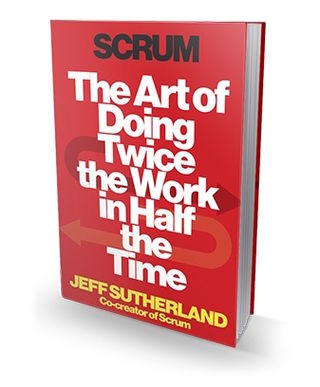Happiness
Happiness Is a Warm Scrum Team
Book Review: Scrum, The Art of Doing Twice the Work in Half the Time
Posted December 2, 2015
People like to say that there’s no such thing as a free lunch, that there are no free rides in life, and that there is no way to do twice the work in half the time. However, a new era is dawning and these adages are not only fading away, but can actually provide the inspiration for disruptive business models. For example, I recently got an absolutely free lunch from Munchery.com, a Bay Area startup that has reeled in $32 million from VC investors, to try out their food gourmet food delivery service. And with a $30 first time user coupon from Uber.com, a free ride was mine as well. Similarly, about doing twice the work in half the time… a famous Agile guru says that it’s actually possible, and that a revolution in how we work is coming at us fast.

Scrum: The Art of Doing Twice the Work in Half the Time, written by Jeff Sutherland, is an indispensible guide to the Agile revolution, and offers a powerful argument for changing the way we work, offers ways to cut through the red tape (sometimes literally with a pair of scissors), and provides some lighter fluid to reignite your team’s sense of purpose at work. Agile scrum is based on a simple idea – instead of trying to generate foot thick specifications and wall-sized Gantt charts, just check in regularly to see if what you’re doing is heading in the right direction and if it’s actually what people want.
The first thing I have to say about this book is that it’s a delight to read. Written in an approachable style, it’s free of jargon and filled with precise arguments and solid scientific backup. And like a good spy novel, the book hits the ground running with an exciting “inciting incident” – how did a large number of suspicious foreigners evade the keen watchers at the FBI to perpetrate the worst terrorist attack in US history? The 9/11 Commission drilled down after the attack and found that much of the fault laid with the poor state of the FBI's information systems. The book explains, “You would write up a document in a word processor and print out three copies. One would be sent up the approval chain. One would be stored locally in case that one got lost. And with the third you'd take a red pen–I'm not kidding, a red pen–and circle the key words for input into the database. You'd index your own report.”
This method was so antiquated that it failed to help agents to ‘connect the dots’ that showed various Al Qaeda activists entering the country in the weeks and months before 9/11, getting flight training without caring about learning how to land, etc. (This is a tangent, but I’ve always wondered why flight training wasn't carefully monitored? Didn’t anyone at the FBI read Tom Clancy’s novel, Debt of Honor –published way back in 1994 – about an embittered pilot flying a Boeing 747 into the U.S. Capitol during a special joint session of Congress?)
Anyway, Sutherland then explains that the FBI had continuously failed in developing what was called the Automated Case Support system – it ran on gigantic mainframe computers that had been state of the art sometime in the 1980s. It was so slow and cumbersome that most agents refused to use it, and had already taken nearly a decade to write and cost hundreds of millions of dollars and barely worked. So they pulled the plug on the project.
Instead, the FBI decided to use Agile methodology to rethink how they developed software. So they brought the development project in-house, cut the number of developers from approximately 220 to 40 and managers from 30 to 12, and promised to deliver the most challenging half of the project in less than a fifth of the time with less than a tenth of the amount budgeted. The skepticism in the usually dry Federal Inspector General reports to Congress was palpable. In the October 2010 report, after laying out their nine points of concern with the proposal, the Inspector General watchdogs concluded: “In sum, we have significant concerns and questions about the ability of this new approach to complete the project within budget, in a timely fashion, and with similar functionality…”
Want to know how it turned out? Get the book. It’s an amazing story with a happy ending. Quite a page turner!
And that’s just chapter one.
Yes, the book’s a page turner, but intellectually stimulating too. Roughly organized in three sections – the origins of Scrum, discussions on the key elements of Scrum that make it work and then chapters that illustrate why things need change in business (and the wider world). You will find something for everyone. The ideas presented resonate to your core, and you get this feeling that this is the way we’ll work in the next century. For me, the chapter that resonated most powerfully was on happiness. Yeah, happiness. Your typical Agile book is loaded with stuff about product backlogs, planning poker, and scrum masters… but if you think about it, when was the last time a book on project management methodology spent time discussing happiness?
Jeff explains, “Happiness is crucial to your business and is actually a better forward predictor of revenue than most of the metrics your CFO provides. In this chapter I'm going to lay out just how important happiness is to your bottom line, and how to capture, measure, and apply it. This is happiness with rigor. Happy people sell more stuff, make more money, cost less, are less likely to leave their jobs, are healthier, and live longer. Happiness leads to success in nearly every domain of our lives, including marriage, health, friendship, community involvement, creativity, and, in particular, our jobs, careers, and businesses.”
The basic theory is that people want to grow; they want to get better at what they're doing and find what else they can get better at. The idea is that mastering work motivates people. Giving employees the chance to win helps to keep them happy, excited, and engaged. In his own work, Jeff has observed productivity triple by simply focusing on improving the happiness of his staff. Jeff found a “happiness metric” to be a leading indicator of productivity increases (or decrease).
If you want to learn more about how to create a Happiness Metric, and to use it to help the team become better people, and remove the causes of unhappiness systematically, then run, don’t walk, to the bookstore to pick up a copy of this book. This metric and everything else the books teaches is that important to you and your business. Published by Crown Business.




